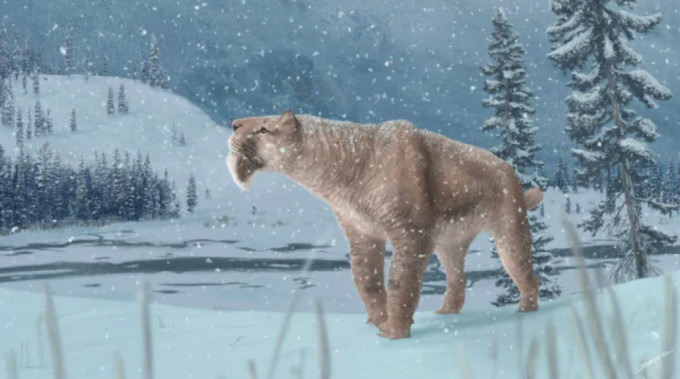Scientists from the University of Toronto and the Royal Ontario Museum have confirmed the Smilodon Fatalis, also known as the sabre-toothed cat, roamed in Canada over 40,000 years ago.
This new study documents the first known occurrence of a Smilodon fossil in Canada, based on a stout partial hand bone of one of the cat’s large forepaws. The fossil was identified during a review of collections at the Royal Ontario Museum. Previously, the most northerly recorded find of Smilodon fossils was in American Falls Reservoir, Idaho. The paper describing the Smilodon bone and remains of other fossils cats from Medicine Hat, Alberta was published online October 4, 2019, in the Canadian Journal of Earth Sciences.
The study also documents bone specimens from three other types of cat, including the American lion (Panthera atrox), a lynx or bobcat (Lynx sp.), and what may be the most southerly record of the cave lion (Panthera cf. Panthera spelaea), which was previously only known in North America from fossils found in Alaska and the Yukon.
“Knowing now that Smilodon’s range extended this far north in Canada tells us a lot more about Pleistocene ecosystems and how they changed over time,” says Ashley Reynolds, a graduate student based at the Royal Ontario Museum who led the study as part of her PhD research in Ecology & Evolutionary Biology at the University of Toronto. “This allows us to learn about how plant and animal communities have responded to changes in the past, and even how they may respond to human-related changes today and in the future.”
Supersized cats like Smilodon and the American lion went extinct the same time as their prey did, at the end of the Pleistocene epoch, around 11,000 years ago.
“These few bones show that at least three large cat species lived in western Canada during the Ice Age” says Dr. Kevin Seymour, co-author and Assistant Curator, Palaeontology, at the Royal Ontario Museum. “This sharply contrasts with today when we have only one large cat in Canada, the mountain lion or cougar, which is smaller than the other big cats that roamed Canada during the Pleistocene.”
The mountain lion’s larger Ice Age cousins, including Smilodon, would have hunted large herbivores that were also present at the time, including camels, horses, giant ground sloths, and young mammoths and mastodons, whereas the mountain lion today hunts mainly deer.
“Smilodon is best known from Tar Pit deposits in California and South America, so it’s both exciting and surprising to find evidence of this iconic sabre-toothed predator in Canada,” says Dr. David Evans, co-author and the ROM’s James and Louise Temerty Endowed Chair of Vertebrate Palaeontology, and Reynolds’ PhD supervisor.
Reynolds’ interest in the comparative anatomy of big cats has led her to specialize in the study of pre-historic cats for her PhD. “I was looking through the ROM’s collections one day to see what we had and was very surprised to find fossils from Alberta labelled as Smilodon,” says Reynolds. “I knew then that we had something really cool.”
The fossils held at the ROM were collected in the late 1960s by University of Toronto palaeontologist C. S. Churcher and colleagues in the area around Medicine Hat, Alberta. With this research paper, the researchers have now confirmed the species to which the bones belonged to. This past summer, Evans and Reynolds followed up by leading a team of graduate students to explore the Ice Age deposits and revisit the fossil sites in Medicine Hat.
The iconic Smilodon has captured the public’s imagination in pop-culture! Young fans of Smilodon may kow the animal as Diego from the movie Ice Age (2002) or from end credits of The Flintstones cartoon that shows Fred unceremoniously putting their sabre-toothed cat, Baby Puss, out of the house every night.















